Sarah L. Johnson's Blog, page 117
June 4, 2013
The passion of design, the design of passion: A review of Ania Szado's Studio Saint-Ex, set in 1940s NYC
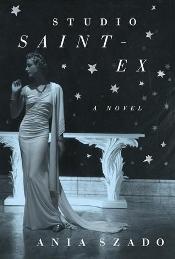 An aspiring clothing designer becomes enmeshed in an unusual triangle in Ania Szado’s debut, a star-studded and alluring literary novel set amid the budding fashion scene in 1940s New York City.
An aspiring clothing designer becomes enmeshed in an unusual triangle in Ania Szado’s debut, a star-studded and alluring literary novel set amid the budding fashion scene in 1940s New York City. Fluent in French due to her family’s expatriate background, 22-year-old Mignonne Lachapelle, the fictional heroine, is asked to help aviator and writer extraordinaire Antoine de St-Exupéry, a family friend, improve his English. Desperate to help with the war effort, “Saint-Ex” has been grounded against his wishes and longs to return to France and fight for his country.
Their tutoring sessions turn passionate quickly, but Mignonne gets caught in the middle when Consuelo, Antoine’s vain and high-maintenance Salvadoran wife, expresses interest in the line produced by the studio where Mignonne is an assistant. Meanwhile, Antoine struggles to write the children’s fable that will earn him lasting acclaim. The St-Exupérys are estranged, more on his part than hers; Consuelo wants him back and uses her wiles on Mignonne as a lure to draw him toward her. Within this complex entangling of ambition and desire, each of the trio fights to grasp what they want most.
Although innocent in some ways, Mignonne transcends her expected ingénue role with her creativity and daring, and the finer technical points of dressmaking are captivating to read about. Szado makes the most of her setting: Manhattan in the troubled and exciting 1940s, when fabric restrictions were in place, yet Paris’s occupation by the Nazis gave Americans the chance to gain the upper hand in haute couture.
The language is tailored to each situation: snappy and pointed within the spoken exchanges, elsewhere as languid and elegant as silk draped against the body. The haunting images of war, tragic yet heart-stoppingly beautiful (“falling planes unfurling smoke like the most exuberant of bridal trains”), emphasize the novel's intermingled themes. The author also poses valid questions about artistic integrity and the purpose and value of fashion.
One minor drawback is that the different timeframes aren’t distinguished clearly. The 1940s segments are framed by Mignonne and Consuelo’s viewpoints as seen 25 years later. The women look back separately on their shared past as Expo ’67 in Montreal gets underway, with its “Man and his World” theme based upon Saint-Exupéry’s work.
Studio Saint-Ex is an imaginative blend of fact and fiction, and anyone curious about the history of fashion should consider picking it up. It really ought to come with a full-color portfolio, too. Mignonne’s creations sound divine.
Ania Szado's Studio Saint-Ex (perfect cover for the book, btw) is published today by Knopf in hardcover ($25.95, 368pp) and on Kindle ($12.99). Viking Canada published it in April (C$30.00).
Published on June 04, 2013 06:00
June 1, 2013
John Boyne's This House is Haunted, an eerie Victorian tale of the supernatural
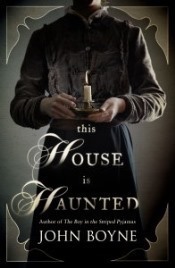
John Boyne applies his dependably fluid writing style to this eerie Victorian ghost story, which offers an unsettling—in a good way—blend of the conventional and the unexpected. Having enjoyed The House of Special Purpose earlier this year, I couldn't resist the opportunity to read his newest, This House is Haunted.
"I blame Charles Dickens for the death of my father," Eliza Caine begins. In London in 1867, after her ailing father dies following a rainy excursion to hear Dickens read his spine-tingling new ghost story, Eliza is left alone and bereft. Overcome by grief and short on cash for the rent, she grabs the first opportunity she sees.
An "H Bennet" has advertised in the newspaper for a governess at Gaudlin Hall in Norfolk. Even knowing little about the environment or her employer, Eliza quits her job as a teacher for "small girls" and boards a train to the country.
In this and in other circumstances, Eliza presents an occasionally frustrating combination of determination and naiveté, one not uncommon to Gothic heroines. Her loyalty and inner strength make her a compassionate, sympathetic protagonist.
Compared to the smoke-filled, crowded city, the Norfolk countryside has plenty of fresh air and open space, but Gaudlin Hall is an imposing old mansion that would give anyone the creeps. The children of the house, the oddly precocious Isabella and her sweet but peculiar younger brother Eustace, have no adult supervision other than Eliza. Their family lawyer refuses to speak with her, local townspeople avoid her once they learn where she works, and the one servant she can find isn't talking. The mysterious “H Bennet” isn’t anywhere around, either.
On Eliza's first night at the house, a malevolent presence makes itself known. Whatever (or whoever) it is wants her gone. Even though she clings to rational explanations for her violent "accidents" past the point of plausibility, she's made of stern stuff and knows she must stay and protect her charges. As the hauntings continue and she meets with more woes, she musters up the courage to solve the mystery of Gaudlin Hall's past.
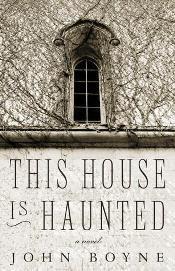 The storyline drew me in with its clear, logical prose and held me gripped with its escalating tension. Even the motivation behind the malice is well thought out: the supernatural occurrences have chillingly lucid reasoning behind them. The novel acknowledges Victorian preoccupations and sensibilities, from the dandy-horse Eliza rides into the village (and is forced off of by an unnatural gust of wind) to a stuffy old clerk’s condescending attitude towards women.
The storyline drew me in with its clear, logical prose and held me gripped with its escalating tension. Even the motivation behind the malice is well thought out: the supernatural occurrences have chillingly lucid reasoning behind them. The novel acknowledges Victorian preoccupations and sensibilities, from the dandy-horse Eliza rides into the village (and is forced off of by an unnatural gust of wind) to a stuffy old clerk’s condescending attitude towards women. The archetypal setting and premise will be familiar ground to anyone who reads Gothics, and there are nods to several well-known novels within—I won’t say which. Maybe due to Eliza's confident narration, the novel never flat-out terrified me, but I appreciated the dramatic plotting and found myself startled by a few revelations. Boyne knows the precise moment to shake things up with a sudden, sharp surprise.
This House is Haunted was published by Doubleday UK in late April at £14.99 (hb, 304pp). American readers can find it in bookstores this October (Other Press, $14.95, trade pb), and Doubleday Canada publishes it the same month ($24.95). Thanks to Doubleday UK for sending me a review copy.
Published on June 01, 2013 05:00
May 30, 2013
A look at Lighthouse Bay by Kimberley Freeman
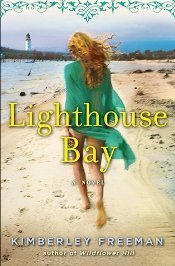 Kimberley Freeman's Lighthouse Bay is an ideal summer book to relax with and immerse yourself in. Even though I can't think who the woman on the cover is supposed to represent – based on her appearance, she's not any of the three main characters – the design does a good job conveying a sense of place and the story's intended effect on the mood of readers.
Kimberley Freeman's Lighthouse Bay is an ideal summer book to relax with and immerse yourself in. Even though I can't think who the woman on the cover is supposed to represent – based on her appearance, she's not any of the three main characters – the design does a good job conveying a sense of place and the story's intended effect on the mood of readers.In Lighthouse Bay, a village on the coast of Queensland, Australia, three women who have lost a loved one are forced to make new lives for themselves, alone, while facing up to their pasts.
In 1901, Isabella Winterbourne's grief for her baby boy, who died three years earlier, is deemed excessive and unseemly by her husband and in-laws. Over a century later, in 2011, Libby Slater can't publicly mourn her lover, Mark Winterbourne, because they had to keep their relationship hidden; he was married. The third protagonist is Libby's estranged younger sister, Juliet. Although she has moved on in some ways from an old loss, although there's been no man in her life for many years.
Isabella's husband and Libby's lover are related, one being the great-great-uncle of the other, but otherwise there's no family connection between the women... although their stories are tied to the same picturesque seaside setting and through the resolution of a mystery dating from Isabella's time.
Isabella and her domineering husband Arthur, of the Winterbourne family of jewelers, are traveling from England to Australia to accompany a ceremonial mace gifted by Queen Victoria to the Australian Parliament in celebration of the country's federation When their barque strikes a reef and breaks apart, leaving Isabella the only survivor, she rows herself ashore, gives herself a new identity, and plans to sell the gems from the mace to earn enough money to leave and find her sister in New York.
In alternating sections, Libby returns home to Lighthouse Bay after a 20-year absence, hoping to continue her life as a graphic designer and reconcile with her sister, Juliet. The owner of a local B&B, Juliet has never forgiven Libby for something tragic that happened years ago. To Lighthouse Bay's modern inhabitants, the lost treasure from the 1901 wreck of the Aurora has become a local legend.
Dual-period novels are all the rage now, and many of their authors generate suspense by moving swiftly between the two timelines; no sooner do we adjust to one character's story than we're jostled out of it and placed into the other era. This isn't the case with Lighthouse Bay, and it makes for a smooth, engrossing journey. Freeman gives her readers time to become intimately acquainted with Isabella's and Libby's experiences, letting us get familiar with each woman's personality and motivations before gently gliding, several chapters later, over to the other tale.
All three women make for sympathetic protagonists, although all have also made mistakes. Libby in particular has much to atone for: not just the rift with Juliet, but her past role as the "other woman."
Society life in each period is deftly sketched: the social strictures at the turn of the 20th century, which guide proper behavior and discourage cross-class liaisons; as well as the strength of community in the 21st century, as residents fight against the threat of resort developers who could destroy their peaceful small-town atmosphere.
There are several romantic subplots, although I won't spoil things by revealing the details. Although tinted with melancholy, Lighthouse Bay is a satisfying and ultimately uplifting novel about the complexities of human relationships, artistic creativity, and how pain from the past must be acknowledged and addressed before it can be overcome.
Lighthouse Bay was published by Touchstone in April at $16, or $18.99 in Canada (trade pb, 416pp). Thanks to the publisher for sending me a review copy.
Published on May 30, 2013 08:35
May 28, 2013
Book review and commentary: The Blood of Heaven, by Kent Wascom
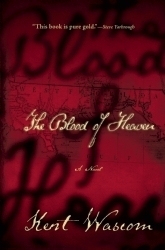 Fueled by whiskey, vengeance, warped religiosity, and wild revolutionary zeal, a golden-haired ruffian and his two adopted brothers aim to fight their way to nation-building glory. Wascom’s language, gorgeous, expressive, and raw, flawlessly matches his vision of the unruly southern frontier before it latched onto the United States.
Fueled by whiskey, vengeance, warped religiosity, and wild revolutionary zeal, a golden-haired ruffian and his two adopted brothers aim to fight their way to nation-building glory. Wascom’s language, gorgeous, expressive, and raw, flawlessly matches his vision of the unruly southern frontier before it latched onto the United States. The son of a Baptist preacher from Upper Louisiana, Angel Woolsack inherits his father’s biblical eloquence and violent tendencies and not only wields them with equal dexterity but liberally intertwines them. From Mississippi River flatboats to a Natchez whorehouse, his picaresque travels shape his mindset and introduce him to Samuel and Reuben Kemper, his partners in crime. His wife, Red Kate, a young woman carved from the same mold, is a similarly powerful presence.
For Angel, the West Florida territory, nominally ruled by the Spanish, is an opportunity to be grabbed, as are Aaron Burr’s dreams of forming an independent country. Seeing early nineteenth-century America through the eyes of an ambitious, trigger-happy renegade makes for an exhilarating yet brutal ride. Wascom imbues this underexplored era with visceral authenticity.
~
Kent Wascom's The Blood of Heaven was published today by Grove in hardcover at $25 (432pp). I read it back in early March, and the review above was published in Booklist's annual historical fiction issue on April 15th. As I had just 175 words to work with (and I always make use of every single one), here are some more personal comments:
(1) If I were to divide books into two categories, the first being "my usual type of book" and the second being everything else, this one would fall into the latter group. This is fine, and this is also why I like reviewing... it drags me out of my comfort zone.
(2) Every review copy comes with endorsements from other writers that trumpet its praises, we know that, but this one arrived with the most jaw-droppingly extraordinary blurbs I've read. I found myself reading them over and over in fascination, mostly for the imagery they created. Go ahead, take a look for yourself.
(3) Samuel and Reuben Kemper were real people; I hadn't heard of them before and am unlikely to forget them now.
(4) This is a novel I greatly admired for many reasons, but whether I enjoyed it is a more difficult question to answer. In parts, I did; the language, for instance, and how perfectly it matched the main character, setting, and tone. (And this isn't something I especially look for, myself, but if you're one of those who reads novels in order to find friends... well, keep looking.) The level of violence didn't appeal to me personally, but those who like their frontier fiction served authentically bloody and grim should grab this book immediately.
Published on May 28, 2013 17:00
May 25, 2013
Contest winners and BEA historical fiction updates
Although it's been quiet here on the blog over the past week, I've been busy updating the list of Historical Fiction Picks at BEA as new information came out Click on over to see the additions. There are many items marked with the -new- designation, which makes the list almost twice as long as it was before.
Congratulations to the winners of two recent giveaways:
Sarah Kennedy's The Altarpiece will be going to Beth M.
Copies of Tony Hays' The Divine Sacrifice have gone out to Chris K. and Linda B.
Thanks to all who entered!
Congratulations to the winners of two recent giveaways:
Sarah Kennedy's The Altarpiece will be going to Beth M.
Copies of Tony Hays' The Divine Sacrifice have gone out to Chris K. and Linda B.
Thanks to all who entered!
Published on May 25, 2013 08:05
May 20, 2013
A Novel Bibliography: A Gallery of Royals and Nobles
I'm a longtime reader and collector of historical fiction with members of royal and noble families as major characters. It's not so much the pomp and pageantry I enjoy reading about (although check out the glamorous gowns in the covers below...) but seeing how each character deals with power and responsibility – and balances the needs of their people against their personal desires. These authors place us front and center, letting us observe how their protagonists' actions shaped the history of their country.
Here I present a gallery of 27 novels fitting this description being published in 2013, ones I haven't previously covered this year (see also Patricia Bracewell's Shadow on the Crown , Sandra Byrd's Roses Have Thorns , and Anne Easter Smith's Royal Mistress ). Although they may not be royal or noble themselves, illegitimate children, hand-fasted wives, and royal mistresses are included in this list, too. Undoubtedly I've been forgetful and left some obvious choices out; please let me know what I'm missing.
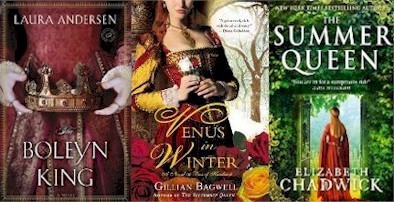
In order:
An alternate history of the Tudors (Ballantine, May)
Bess of Hardwick, Countess of Shrewsbury (Berkley, July)Eleanor of Aquitaine, first in a new trilogy (Sphere, June)
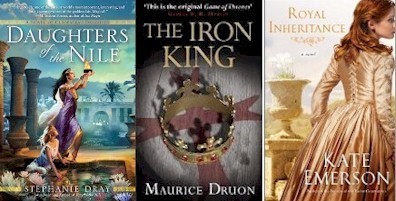
Cleopatra Selene, Queen of Mauretania, last in a trilogy (NAL, Dec)Philip IV of France, 1st in classic series (HarperCollins, Mar)
Audrey Malte, illegitimate daughter of Henry VIII (Gallery, Sept)
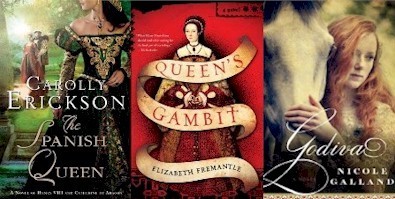
Catherine of Aragon (St. Martin's, Oct)
Katherine Parr (Simon & Schuster, Aug)
Lady Godiva, wife of Leofric, Earl of Mercia (William Morrow, July)

Queen Jezebel (David C. Cook, May)Elizabeth I Spymaster Chronicles, book 2 (St. Martin's Griffin, July)Elizabeth of York, queen to Henry VII (Touchstone, Aug)
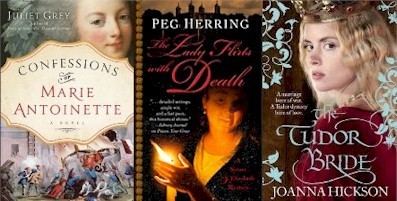
Marie Antoinette, book 3 in trilogy (Ballantine, Sept)
Elizabeth Tudor as sleuth, 3rd in series (Five Star, June)
Catherine de Valois, Henry V's queen, follows Agincourt Bride (Harper UK, Oct)
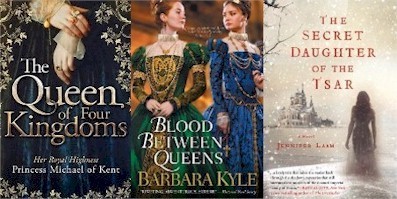
Yolande of Aragon, Duchess of Anjou (Constable, Oct)
Elizabeth I & Mary Q of Scots; 5th in Thornleigh saga (Kensington, May)Alternate history of the Romanovs (St. Martin's Griffin, Oct)
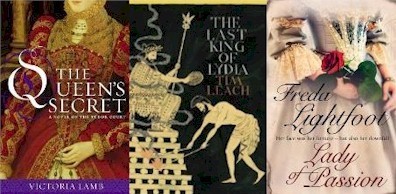
Elizabeth I, Robert Dudley, and singer Lucy Morgan (Berkley, Feb)
Croesus, King of Lydia in the 6th century BC (Atlantic UK, Apr)
Mary Robinson, mistress to the future George IV (Severn House, June)
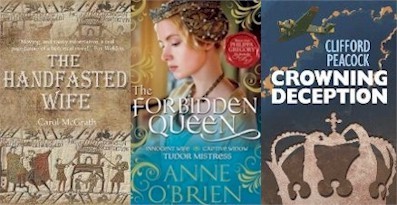
Edith Swan-Neck, handfasted wife of Harold II (Accent, May)
Katherine de Valois, queen of Henry V (MIRA UK, Mar)
Magda Lupescu, mistress of Carol II of Romania (Severn House, Aug)
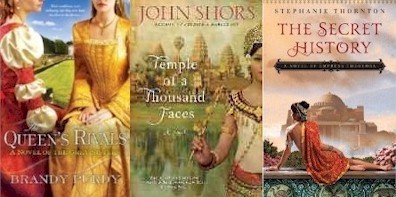
Katherine and Mary Grey, Tudor heiresses (Kensington, June)
Prince Jayavar of the Khmer Empire in 12th-c Cambodia (NAL, Feb)
Theodora, Empress of Byzantium (NAL, July)
Here I present a gallery of 27 novels fitting this description being published in 2013, ones I haven't previously covered this year (see also Patricia Bracewell's Shadow on the Crown , Sandra Byrd's Roses Have Thorns , and Anne Easter Smith's Royal Mistress ). Although they may not be royal or noble themselves, illegitimate children, hand-fasted wives, and royal mistresses are included in this list, too. Undoubtedly I've been forgetful and left some obvious choices out; please let me know what I'm missing.

In order:
An alternate history of the Tudors (Ballantine, May)
Bess of Hardwick, Countess of Shrewsbury (Berkley, July)Eleanor of Aquitaine, first in a new trilogy (Sphere, June)

Cleopatra Selene, Queen of Mauretania, last in a trilogy (NAL, Dec)Philip IV of France, 1st in classic series (HarperCollins, Mar)
Audrey Malte, illegitimate daughter of Henry VIII (Gallery, Sept)

Catherine of Aragon (St. Martin's, Oct)
Katherine Parr (Simon & Schuster, Aug)
Lady Godiva, wife of Leofric, Earl of Mercia (William Morrow, July)

Queen Jezebel (David C. Cook, May)Elizabeth I Spymaster Chronicles, book 2 (St. Martin's Griffin, July)Elizabeth of York, queen to Henry VII (Touchstone, Aug)

Marie Antoinette, book 3 in trilogy (Ballantine, Sept)
Elizabeth Tudor as sleuth, 3rd in series (Five Star, June)
Catherine de Valois, Henry V's queen, follows Agincourt Bride (Harper UK, Oct)

Yolande of Aragon, Duchess of Anjou (Constable, Oct)
Elizabeth I & Mary Q of Scots; 5th in Thornleigh saga (Kensington, May)Alternate history of the Romanovs (St. Martin's Griffin, Oct)

Elizabeth I, Robert Dudley, and singer Lucy Morgan (Berkley, Feb)
Croesus, King of Lydia in the 6th century BC (Atlantic UK, Apr)
Mary Robinson, mistress to the future George IV (Severn House, June)

Edith Swan-Neck, handfasted wife of Harold II (Accent, May)
Katherine de Valois, queen of Henry V (MIRA UK, Mar)
Magda Lupescu, mistress of Carol II of Romania (Severn House, Aug)

Katherine and Mary Grey, Tudor heiresses (Kensington, June)
Prince Jayavar of the Khmer Empire in 12th-c Cambodia (NAL, Feb)
Theodora, Empress of Byzantium (NAL, July)
Published on May 20, 2013 05:00
May 18, 2013
Book review: The Bookman's Tale: A Novel of Obsession, by Charlie Lovett
Lovett’s enjoyable homage to books and bookishness opens, fittingly, in that literary magnet known as Hay-on-Wye in Wales. In 1995, Peter Byerly, an American book dealer, is living in Oxfordshire after the death of his beloved wife, Amanda. She had served as the link between her shy husband and the social world he dreaded, and now, depressed and lonely, he buries himself in his career. When he finds a Victorian watercolor bearing Amanda’s likeness tucked into an old bookshop volume about Shakespearean forgeries, Peter gets pulled into solving two interrelated mysteries: learning more about the mysterious woman, and finding indisputable proof of the identity of England’s greatest playwright.
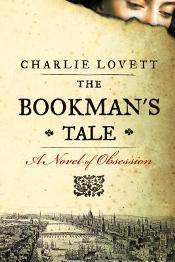 The narrative jumps between Peter’s investigation and his touching romance with Amanda in the 1980s, which unfolds in a North Carolina university library. In intervening segments, the plot also dramatizes the lives of the successive owners of a long-lost text, Robert Greene’s Pandosto, which inspired one of Shakespeare’s last plays. The boisterousness of London’s Southwark is shown to good effect in the story of Bartholomew Harbottle, a bookseller who counts many Elizabethan dramatists as his drinking buddies. Not all of the subsequent historical scenes are as interesting; although it’s critical to the puzzle, the final tale of Victorian rivalries feels slightly superficial in comparison. However, anyone who loves literature should like seeing how a book’s provenance comes to life.
The narrative jumps between Peter’s investigation and his touching romance with Amanda in the 1980s, which unfolds in a North Carolina university library. In intervening segments, the plot also dramatizes the lives of the successive owners of a long-lost text, Robert Greene’s Pandosto, which inspired one of Shakespeare’s last plays. The boisterousness of London’s Southwark is shown to good effect in the story of Bartholomew Harbottle, a bookseller who counts many Elizabethan dramatists as his drinking buddies. Not all of the subsequent historical scenes are as interesting; although it’s critical to the puzzle, the final tale of Victorian rivalries feels slightly superficial in comparison. However, anyone who loves literature should like seeing how a book’s provenance comes to life.
Tomb-robbing, blackmail, family secrets, and murder all play a part in this complex work, and with the help of some fortunate coincidences, the pieces all lock together. Lovett, a former antiquarian book dealer, obviously knows his stuff, and his readers will get a fun education in the rare book trade. With its comfortable style, The Bookman’s Tale is more charming than suspenseful, but just as one would hope for with a novel about books, it’s a pleasure to read.
The Bookman's Tale will appear on May 28th from Viking ($27.95/C$29.50, hb, 352pp). Alma Books publishes it in the UK in July (£7.99). This was one I chose to cover for May's Historical Novels Review. It was just picked as the latest title in the Barnes & Noble Recommends program, so expect to see a lot of it at your local B&N.
 The narrative jumps between Peter’s investigation and his touching romance with Amanda in the 1980s, which unfolds in a North Carolina university library. In intervening segments, the plot also dramatizes the lives of the successive owners of a long-lost text, Robert Greene’s Pandosto, which inspired one of Shakespeare’s last plays. The boisterousness of London’s Southwark is shown to good effect in the story of Bartholomew Harbottle, a bookseller who counts many Elizabethan dramatists as his drinking buddies. Not all of the subsequent historical scenes are as interesting; although it’s critical to the puzzle, the final tale of Victorian rivalries feels slightly superficial in comparison. However, anyone who loves literature should like seeing how a book’s provenance comes to life.
The narrative jumps between Peter’s investigation and his touching romance with Amanda in the 1980s, which unfolds in a North Carolina university library. In intervening segments, the plot also dramatizes the lives of the successive owners of a long-lost text, Robert Greene’s Pandosto, which inspired one of Shakespeare’s last plays. The boisterousness of London’s Southwark is shown to good effect in the story of Bartholomew Harbottle, a bookseller who counts many Elizabethan dramatists as his drinking buddies. Not all of the subsequent historical scenes are as interesting; although it’s critical to the puzzle, the final tale of Victorian rivalries feels slightly superficial in comparison. However, anyone who loves literature should like seeing how a book’s provenance comes to life. Tomb-robbing, blackmail, family secrets, and murder all play a part in this complex work, and with the help of some fortunate coincidences, the pieces all lock together. Lovett, a former antiquarian book dealer, obviously knows his stuff, and his readers will get a fun education in the rare book trade. With its comfortable style, The Bookman’s Tale is more charming than suspenseful, but just as one would hope for with a novel about books, it’s a pleasure to read.
The Bookman's Tale will appear on May 28th from Viking ($27.95/C$29.50, hb, 352pp). Alma Books publishes it in the UK in July (£7.99). This was one I chose to cover for May's Historical Novels Review. It was just picked as the latest title in the Barnes & Noble Recommends program, so expect to see a lot of it at your local B&N.
Published on May 18, 2013 19:17
May 16, 2013
Nuns and Mothers: A guest post by Sarah Kennedy, author of the Altarpiece (plus giveaway)
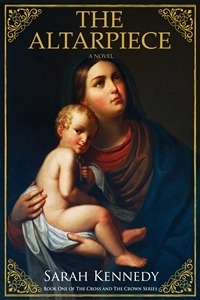 Sarah Kennedy, author of
The Altarpiece
, is here at the blog today with a thoughtful essay about the concept of motherhood in Renaissance convents. Her main character, Catherine Havens, is a nun in remote northern Yorkshire during a perilous time: Henry VIII's Dissolution of the Monasteries. Catherine and a fellow sister come under suspicion when their priory's altarpiece disappears.
Sarah Kennedy, author of
The Altarpiece
, is here at the blog today with a thoughtful essay about the concept of motherhood in Renaissance convents. Her main character, Catherine Havens, is a nun in remote northern Yorkshire during a perilous time: Henry VIII's Dissolution of the Monasteries. Catherine and a fellow sister come under suspicion when their priory's altarpiece disappears. The Altarpiece (Knox Robinson, March 2013, $25.99) is the first novel in the Crown and Cross series. We have a giveaway opportunity at the end as well (for US readers).
~
Nuns and Mothers
Sarah Kennedy
When I created Catherine Havens, the main character of The Altarpiece, I made her parentage uncertain. She’s lived her whole life in the convent, under the eyes of the prioress, Christina, and the oldest nun, Veronica. I wanted Catherine’s life to be woman-centered as a way of rethinking the roles of parents in Renaissance Europe.
Most Early Modern women were governed by their fathers and husbands, but life in the convent could be the exception. We sometimes think of convent life as constrained, and of course it was controlled and demanding. But in addition to providing (1) an escape from unwanted marriage, (2) some safety from contagious disease, (3) an opportunity for education beyond the traditional female accomplishments of sewing and music, and (4) positions of real power, nunneries made the mother the primary parent.
The Father was still present, but God the Father was in heaven rather than the next room. Every convent required the services of at least one priest, but he neither lived within their walls nor oversaw much of the daily administration. The Husband of these “brides of Christ” was also in heaven and was always perfect, mild, and loving.
But the Mother? The second parent in the secular world, she was dominant in the convent in the figure of the abbess or the prioress. In heaven, the Mother of God was a compassionate and accessible figure. If God dealt punishment to sinners, Mary might be petitioned to intervene on behalf of His suffering children. Even Jesus was seen as a mother, most famously by the mystic Julian of Norwich. In my convent, the titular altarpiece features an image of Mary, and this would not have been unusual. Catherine has, as she says, “prayed under Her eyes” all of her life. It should be no surprise, then, that Catherine believes that she can make decisions about her beliefs and her desires without consulting a father.
Some abbesses no doubt took advantage of their power (Hildegard of Bingen was notoriously cruel to novices and lay sisters), but a good Mother had more influence than anyone else in the convent. Not every nun could aspire to her authority, but the precedent was there, and women did find expressions of their creative, political, and personal ambitions through the female hierarchy of the pre-Reformation convents, as Catherine does in her work as a healer and a compiler of medical books.
The critic Joan Kelly, back in 1977, provocatively asked whether women had a Renaissance. She concluded that while men were exploring the “new learning,” Protestant women were relegated to secondary positions—with no respectable alternative. Husbands were recast as domestic religious authorities in the place of priests. Unmarried women were condemned, as Shakespeare’s Beatrice says, to “lead apes in hell.”
And this is, in part, why the notion of the Mother is so important to my nun. She’s Mother of God and living woman, model of power and learning. The ideal Protestant mother soon became the “angel in the house”: submissive, selfless, and silent. She was perfectly secondary, which, of course, no real woman is. What I wanted to recreate was a complex, true set of Mothers who work and love and, yes, sin as all of us do, even in the house of God.
~
 Credit: Sarah KennedySarah Kennedy is a professor of English at Mary Baldwin College in Staunton, Virginia and the author of seven books of poems.
Credit: Sarah KennedySarah Kennedy is a professor of English at Mary Baldwin College in Staunton, Virginia and the author of seven books of poems. She holds a PhD in Renaissance Literature and an MFA in Creative Writing.
Sarah has received grants from both the National Endowment for the Arts and the Virginia Commission for the Arts and is currently a contributing editor for Shenandoah.
Sarah will publish a series of novels with Knox Robinson centering around the sixteenth century closure of the monasteries and convents of England by King Henry VIII. Visit her website at http://sarahkennedybooks.wordpress.com.
For a chance to win a copy of The Altarpiece (to be mailed out by the author's publicist), please fill out the form below. Open to US readers. The winner will be selected by the random number generator at Random.org; deadline Friday, May 24th.
>Loading...
Published on May 16, 2013 05:00
May 14, 2013
Book review: Z: A Novel of Zelda Fitzgerald, by Therese Anne Fowler
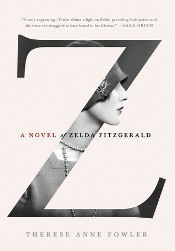 An intimate portrait of a flamboyantly public marriage, Z imagines Zelda Fitzgerald’s voice in this exhilarating account of a life lived in decadent, full color. During the Jazz Age, Zelda and F. Scott Fitzgerald personified the era’s reckless abandon. Their decades-long love story played out in New York and Europe as they attended parties, spent wads of cash, and fought their inner demons and each other as they struggled to create art of their own. Their union derailed into excessive drinking (his), mental illness (hers), and mutual accusations of thwarted ambition. It’s clear from the beginning that the momentum could never have lasted, but the telling makes for great escapism.
An intimate portrait of a flamboyantly public marriage, Z imagines Zelda Fitzgerald’s voice in this exhilarating account of a life lived in decadent, full color. During the Jazz Age, Zelda and F. Scott Fitzgerald personified the era’s reckless abandon. Their decades-long love story played out in New York and Europe as they attended parties, spent wads of cash, and fought their inner demons and each other as they struggled to create art of their own. Their union derailed into excessive drinking (his), mental illness (hers), and mutual accusations of thwarted ambition. It’s clear from the beginning that the momentum could never have lasted, but the telling makes for great escapism. Zelda narrates her own tale, beginning as an uninhibited Alabama teenager and moving through her marriage to an ambitious, as-yet-unknown writer, their years of notoriety, the birth of daughter Scottie, and their final tragic decline. Perhaps Fowler has filed some edges off the real Zelda’s personality to make her more sympathetic, but her daring and confidence still leap from the page.
The characterization avoids stereotypes, and all the name-dropping is done with purpose. Their social circle includes H. L. Mencken, Cole Porter, and Ernest Hemingway, the latter an attention-seeking “extra-manly man” whose complicated relationship with both Fitzgeralds is envisioned brilliantly (and controversially, no doubt). No major segments of their marriage are omitted, but the plot has a constant forward motion that ensures the reading is never dull.
The novel deftly explores the uneasy intersections between literature and real life, with Zelda embodying the brashness and style of Scott’s flapper heroines, and Zelda’s uphill battle for artistic acceptance is convincing and heartfelt. To earn them more money, her published writings were often credited at least partially to him, which she was deeply conflicted about – understandably so. With her engrossing novel about an unconventional heroine, Fowler makes a persuasive case that Zelda deserves to stand in her own spotlight.
This review was written up for May's Historical Novels Review, which was a spur-of-the-moment decision. I had gotten a galley from a Shelf Awareness ad and picked it up after finishing several rather intense literary novels. I was eager to learn more about Zelda and be entertained. Then I got sucked into the story, and after determining that HNR hadn't gotten a copy of the book yet, I figured I should review it.
Therese Anne Fowler's Z was published by St. Martin's Press in April ($25.99/C$29.99, hb, 375pp).
Published on May 14, 2013 10:34
May 13, 2013
Why Nadya—but not Wallis? A guest post by Kat Meads, author of For You, Madam Lenin
 Why do some subjects lend themselves well to fictional treatment while others don't? This, of course, is a question that all novelists must work out for themselves. Kat Meads is visiting the blog today with an essay that explores this complex issue and provides insight into her own decision-making process.
Why do some subjects lend themselves well to fictional treatment while others don't? This, of course, is a question that all novelists must work out for themselves. Kat Meads is visiting the blog today with an essay that explores this complex issue and provides insight into her own decision-making process.Kat's novel For You, Madam Lenin examines the life of Nadya Krupskaya, a Bolshevik revolutionary who married her fellow comrade Vladimir Lenin. Reviewing for the Historical Novels Review, Elena Maria Vidal wrote: "Kat Meads' exquisite prose brings to life one of the most determined and enigmatic women in history in a story which exemplifies with irony, pathos and dark humor that there is no tragedy like a Russian tragedy." For You, Madam Lenin recently took home a silver medal in the IPPY Awards and was a finalist for the ForeWord Book of the Year.
~
Why Nadya—but not Wallis? Kat Meads
I spent eight years and then some researching, writing, revising and publishing For You, Madam Lenin (Livingston Press, 2012), a novel whose principal characters are Nadya Krupskaya and her mother, Yelizaveta (not the more famous fellow they hung about with). The novel I spent three years researching, outlining, starting, stopping and brooding over was supposed to feature Wallis Warfield Spencer Simpson Windsor, a woman who became, in the course of her lifetime, a personage at least as famous as the fellow who renounced the throne on her behalf.
Which made and makes me wonder: did degree of real-life famousness turn out to be a deciding factor in which character I kept with, which novel I finished and which I scuttled?
A story too well known, too familiar, resisting fictional recast?
Makes sense.
Because if the historical record has already revealed the secrets, exposed the dark corners, filled in the missing blanks, there would be—would have to be—fewer mysteries going in, less need to invent, less incentive, one might say, for the fictioneer to whip up fiction.
Did Wallis Windsor’s universal notoriety ultimately put me off my own project?
I don’t think it helped.
In retrospect, I honestly don’t think it did.
Prior to starting in on Madam Lenin, I do remember this motivator: write a “bigger” novel. Bigger in terms of page count, character count, narrative scope, narrative time. My previous novels’ timeframes were fairly limited. The Invented Life of Kitty Duncan covers twenty years, give or take; Sleep, a few months; when the dust finally settles, a few weeks. Madam Lenin’s plot is driven by 50-odd years of turbulent Russian history and peopled by three times as many characters as my usual fictional cast. It’s a book that starts in the 1890s, that takes place in countries not my own, a book about revolution(s). Revolutions are not solitary affairs. Anytime I wanted a break from writing about Nadya K, I could write about Inessa Armand, Nadya’s comrade and rival for Lenin’s affections. Or about Fanny Kaplan, the woman accused of shooting Lenin in 1918. Or about the tsarina. Or, or, or. In the Wallis novel as conceived, Wallis was front and center, dominating every page.
Did I lose faith in that singular focus, grow tired of the company of the self-absorbed Wallis?
Maybe so.
The writer James Houston once told me: “One of the things young writers don’t understand is that you have to enjoy your own company. You have to be okay with being alone at your desk for long stretches of time.”
I’d add to that you have to be okay with spending long stretches with your characters. You don’t have to like them, but they do have to hold your interest. Because if they don’t hold your interest, what chance do they have of holding a reader’s?
No chance is the definitive answer to that.
When I sift through the whys of my original attraction to Nadya Krupskaya and Wallis Warfield as characters, the list turns up a few similarities, a few stark differences. Nadya Krupskaya was a politically radical, politically committed female, young and old. Wallis Warfield was a Southerner turned duchess, petrified of poverty, young and old. Both were intent on changing something: Nadya, a country; Wallis, the uncertain nature of her own future. Both women were exceedingly skilled at holding grudges. Both, young and younger, had lost their fathers, an absence that intensified their relationships with their mothers. I have long written about mothers and daughters. I am Southern. And yet I was only able to go the distance with the Russian mother/daughter pair, not my regional affiliates.
Was it a matter of perseverance, determination, grit and grind? If I’d kept pushing my Wallis idea, would I eventually have figured out a way to write my unwritten novel?
Doubtful.
More importantly: would I have been satisfied with the result?
More doubtful still.
Even now, when I think of Wallis Warfield Windsor, I recall what others have written about her—not my ideas, my notion of spin. I was never able to make/remake Wallis into “my” character, my “creature.” Wallis resisted my manipulations. She stubbornly remained Wallis, a woman in history.
Nadya Krupskaya?
The flesh and blood NK who inspired the novel?
She’s gone. Utterly displaced and replaced by NK The Character in my head. Ask me anything about NK The Character, and I’ll answer promptly. Ask one of those “Did that really happen?” questions and I’m likely to hem and haw. Because, frankly, I can no longer easily remember what is true and what I invented. The same applies to Russian Revolution specifics. Once upon a time, I could do fair justice to Edmund Wilson’s account of the Bolsheviks’ reception at Finland Station; now I’m a For You, Madam Lenin expert, period.
Safe to say: for me to claim to know a novel inside out, upside down, sideways and aslant, that novel has to exist.
And that, at least, the Madam does.
She does exist.
~
For You, Madam Lenin was published by Livingston Press of the University of West Alabama in October 2012 ($19.99, trade pb, 283pp). Find it on Goodreads and on Amazon. Visit Kat Meads' website at www.katmeads.com.
Published on May 13, 2013 06:30



